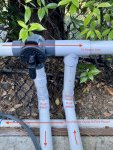Maybe have someone use a pump to pull water from the skimmer to see if anything comes out.
Do you know for sure what the plumbing is that feeds the pump?
Is it a single 1.5" line?
Do you know for sure what the plumbing is that feeds the pump?
Is it a single 1.5" line?


